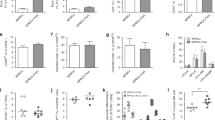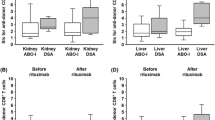Abstract
Medawar and co-workers originally demonstrated that injection of donor bone marrow (DBM) into immuno-incompetent neonatal rodents could induce tolerance to grafts from animals of the same strain as the bone marrow donor1. Induction of tolerance in this manner can also be accomplished in mature mice, dogs and monkeys if the resident T-cell populations in the recipient are depleted by a polyclonal antithymocyte globulin or an anti-T cell immunotoxin2–4. The molecular mechanisms by which bone marrow cells mediate the induction of tolerance remain uncertain. Here we examined a well-established adult mouse model of antithymocyte globulin and DBM treatment and show that expression of functional Fas ligand (FasL, also CD95L) on the injected bone marrow cells is required for tolerance induction. The results indicate that a state of microchimerism perse is insufficient for the induction of tolerance in T cell-depleted transplant recipients. Moreover, the results are consistent with the hypothesis that tolerance induced by DBM involves an apoptotic process leading to deletion of graft-reactive cells.
This is a preview of subscription content, access via your institution
Access options
Subscribe to this journal
Receive 12 print issues and online access
$209.00 per year
only $17.42 per issue
Buy this article
- Purchase on Springer Link
- Instant access to full article PDF
Prices may be subject to local taxes which are calculated during checkout
Similar content being viewed by others

References
Billingham, R.E., Brent, L. & Medawar, P.B. ‘Actively acquired tolerance‘ of foreign cells. Nature 172, 603–606 (1953).
Hartner, W.C. et al. Specific tolerance to canine renal allografts following treatment with fractionated bone marrow and antilymphocyte serum. Transplant. Proc. 19, 476–477 (1987).
Gozzo, J.J., Wood, M.L. & Monaco, A.P. Use of allogenic, homozygous bone marrow cells for the induction of specific immunologic tolerance in mice treated with antilymphocyte serum. Surg. Forum 21, 281–284 (1970).
Thomas, J.M. et al. Renal allograft tolerance induced with ATG and donor bone marrow in outbred rhesus monkeys. Transplantation 36, 104–106 (1983).
Monaco, A.P., Wood, M.L., Maki, T. & Gozzo, J.J. The use of donor-specific bone marrow to induce specific unresponsiveness (tolerance) to tissue allografts. Chimerism and Tolerance (ed. lldstad, K.J.) 99–113 (Landes, Austin, 1995).
Takahashi, T. et al. Generalized lymphoproliferative disease in mice, caused by a point mutation in the Fas ligand. Cell 76, 969–976 (1994).
Sharabi, Y., Abraham, V.S., Sykes, M. & Sachs, D.H. Mixed allogeneic chimeras prepared by a non-myelablative regimen: requirement for chimerism to maintain tolerance. Bone Marrow Transplant 9, 191–197 (1992).
Smith, J.P., Kasten-jolly, J., >Field, L.J. & Thomas, J.M. Assessment of donor bone marrow cell-derived chimerism in transplantation tolerance using transgenic mice. Transplantation 58, 324–329 (1994).
Starzl, T.E. et al. The lost chord: Microchimerism and allograft survival [review]. Immunol. Today 17, 577–84; discussion 588 (1996).
Lubaroff, D.M. & Silvers, W.K. Importance of chimerism in maintaining tolerance of skin allografts in mice. J. Immunol. 111, 65–71 (1973).
Bergstrom, D.E. et al. An expanded collection of mouse Y chromosome RDA clones. Mammal. Genome 8, 510–512 (1997).
Nagata, S. & Suda, T. Fas and Fas ligand: lpr and gld mutations [review]. Immunol. Today 16, 39–43 (1995).
Verbanac, K.M., Carver, F.M., Haisch, C.E. & Thomas, J.M. A role for transforming growth factor-beta in the veto mechanism in transplant tolerance. Transplantation 57, 893–900 (1994).
Thomas, J.M. et al. Further studies of veto activity in rhesus monkey bone marrow in relation to allograft tolerance and chimerism. Transplantation 57, 101–115 (1994).
Zhang, L., Fung-Leung, W. & Miller, R.G. Down-regulation of CD8 on mature antigen-reactive T cells as a mechanism of peripheral tolerance. J. Immunol. 155, 3464–3471 (1995).
Martin, P.J. Donor CD8 cells prevent allogeneic marrow graft rejection in mice: Potential implications for marrow transplantation in humans. J. Exp. Med. 178, 703–712 (1993).
Kaufman, C.L. et al. Phenotypic characterization of a novel bone marrow-derived cell that facilitates engraftment of allogeneic bone marrow stem cells. Blood 84, 2436–2446 (1994).
Wood, K.J. Antigen induced tolerance. Chimerism and Tolerance (ed. lldstad, K.J.) 15–29 (Landes, Austin, 1995).
Sayegh, M.H. & Turka, L.A. T cell costimulatory pathways: Promising novel targets for immunosuppression and tolerance induction [editorial]. J. Am. Soc. Nephrol. 6, 1143–1150 (1995).
Ju, S.T., et al. Fas(CD95)/FasL interactions required for programmed cell death after T-cell activation [see comments]. Nature 373, 444–448 (1995).
Author information
Authors and Affiliations
Rights and permissions
About this article
Cite this article
George, J., Sweeney, S., Kirklin, J. et al. An essential role for Fas ligand in transplantation tolerance induced by donor bone marrow. Nat Med 4, 333–335 (1998). https://doi.org/10.1038/nm0398-333
Received:
Accepted:
Issue Date:
DOI: https://doi.org/10.1038/nm0398-333
This article is cited by
-
Hematopoietic stem cell transplantation across major genetic barriers
Immunologic Research (2007)
-
Stemming the tide of rejection
Nature Medicine (2002)
-
Preimplantation-stage stem cells induce long-term allogeneic graft acceptance without supplementary host conditioning
Nature Medicine (2002)
-
Induction of tolerance in autoimmune diseases by hematopoietic stem cell transplantation: Getting closer to a cure?
International Journal of Hematology (2002)


